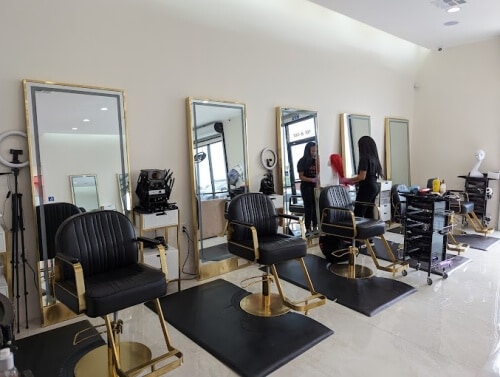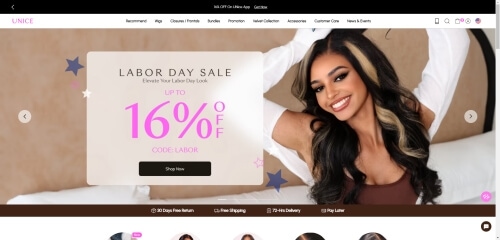How to Start a Hair Business from Scratch?
The hair industry offers immense opportunities. The global hair and scalp care market is expected to reach a staggering USD 134.30 billion by 2028. This growth highlights the industry's potential for aspiring entrepreneurs. Starting a hair business from scratch might seem daunting, but the journey can be rewarding. Many people seek quality products like human hair wigs and human hair bundles. Entrepreneurs can tap into this demand.

Source: pixlr.com
Learning how to start a hair business involves understanding the market and exploring options like hair wholesale. With determination, anyone can transform a passion for hair into a thriving business.
How to Start a Hair Business: Research and Planning
Starting a hair business requires careful research and planning. You need to understand the market and create a solid plan. Let's dive into the steps you need to take.
Understanding the Market
Analyzing Industry Trends

Source: unice.com
You should start by analyzing industry trends. Look at what products are popular. Check out what customers are buying. The hair industry is always changing. Staying updated helps you make smart decisions. You can read industry reports or follow hair business blogs. This knowledge will guide your business choices.
Identifying Target Audience
Next, identify your target audience. Who will buy your products? Are they young adults or older professionals? Knowing your audience helps you tailor your products. You can conduct surveys or use social media to gather information. Understanding your audience is key to success.
Developing a Business Plan
Setting Clear Goals
A business plan is essential. Start by setting clear goals. What do you want to achieve in the first year? Goals give you direction. Write down specific targets like sales numbers or customer growth. Clear goals keep you focused and motivated.
Outlining Business Structure
Outline your business structure next. Decide if you want a sole proprietorship or a partnership. Each structure has pros and cons. Consider how each option affects taxes and liability. Choose the structure that fits your vision for the business.
Legal Considerations
Registering Your Business
Legal considerations are crucial. You need to register your business. Registration makes your business official. It also protects your brand name. Check with local authorities for the registration process. Make sure you have all the necessary documents.
Understanding Regulations
Understanding regulations is important too. Different areas have different rules. You need to know about health and safety standards. Research the licenses you need to operate legally. Following regulations avoids legal issues and builds trust with customers.
Learning how to start a hair business involves these steps. Research and planning lay the foundation for success. With the right preparation, you can turn your dream into reality.
Setting Up Your Business
Choosing a Business Model
Online vs. Brick-and-Mortar

Source: unice.com
Decide if you want an online store or a physical location. An online wig store lets you reach customers worldwide. You save on rent and utilities. A brick-and-mortar store offers face-to-face interaction. Customers can see and touch products before buying. Consider your budget and target audience. Choose the model that suits your goals. Here are some UNice hair salons in the US.
FAQs About UNice Hair Salon in Stone Mountain, GA
FAQs about UNice Hair Salon in Inglewood
FAQs about UNice Hair Salon in Carson, CA
Product vs. Service-Based

Source: unice.com
Determine if you will sell products or offer services. Selling products like wigs and extensions can be lucrative. Offering services like styling and treatments attracts clients seeking expertise. Think about your skills and resources. Decide which approach aligns with your vision for the business.
Sourcing Products
Finding Reliable Suppliers
Find suppliers who provide quality products. Research potential suppliers online. Read reviews from other businesses. Attend trade shows to meet suppliers in person. Ask for samples to test product quality. Build relationships with trustworthy suppliers. Reliable suppliers ensure consistent inventory.
Quality Control Measures
Implement quality control measures for your products. Inspect each shipment for defects. Test products to ensure they meet standards. Train staff to recognize quality issues. Maintain high standards to satisfy customers. Quality control builds trust and reputation.
Branding and Identity
Creating a Unique Brand
Create a brand that stands out. Think about what makes your business special. Develop a brand story that resonates with customers. Use colors and fonts that reflect your style. Consistent branding creates a memorable impression. A unique brand attracts loyal customers.
Designing a Logo and Packaging
Design a logo that represents your business. Use online tools to create a professional logo. Choose colors and symbols that match your brand identity. Design packaging that complements your logo. Eye-catching packaging enhances the customer experience. A strong logo and packaging boost brand recognition.
Marketing Your Hair Business
Building an Online Presence
Creating a Website

Source: unice.com
A website serves as your digital storefront. Start by choosing a user-friendly platform to build your site. Include essential pages like "About Us," "Services," and "Contact." Ensure that the website design reflects your brand's style. High-quality images of your products attract visitors. Integrate an online booking system if you offer services. This feature simplifies the appointment process for clients. Regularly update your website with new content to keep it fresh.
Utilizing Social Media Platforms

Source: unice.com
Social media platforms like Instagram and Facebook boost your visibility. Use Instagram to showcase transformations in your salon. Before-and-after pictures grab attention and highlight your skills. Post content that represents your company's vision. This strategy attracts followers who align with your brand ethos. Engage with your audience by responding to comments and messages. Consistent interaction builds a community around your brand.
Leveraging Free Marketing Tools
Email Marketing Strategies
Email marketing keeps your audience informed and engaged. Start by collecting email addresses through your website or in-store. Send newsletters with updates on new products and promotions. Personalize emails to make recipients feel valued. Offer exclusive discounts to subscribers to encourage loyalty. Track open rates and click-throughs to measure success. Adjust your strategy based on these insights.
Collaborations and Partnerships
Collaborations expand your reach and introduce your brand to new audiences. Partner with influencers who align with your brand values. Influencers can showcase your products to their followers. Collaborate with local businesses for joint promotions. This approach benefits both parties by sharing customer bases. Host events or workshops to engage with potential clients directly. Partnerships create opportunities for growth and exposure.
Customer Engagement
Building a Loyal Customer Base
Loyal customers drive repeat business and referrals. Provide exceptional service to exceed client expectations. Implement a loyalty program to reward frequent customers. Offer incentives like discounts or free services after a certain number of visits. Encourage satisfied clients to leave reviews online. Positive reviews enhance your reputation and attract new customers. Stay connected with clients through personalized communication.
Handling Customer Feedback
Customer feedback offers valuable insights into your business. Encourage clients to share their thoughts and experiences. Use surveys or feedback forms to gather opinions. Address any concerns promptly to show you value customer input. Implement changes based on constructive feedback to improve services. Thank customers for their feedback to foster goodwill. A responsive approach builds trust and strengthens relationships.
Managing Finances
Setting Up Financial Accounts
Opening a Business Bank Account
Starting a hair business requires a dedicated business bank account. This account keeps personal and business finances separate. A separate account simplifies tax filing and financial tracking. Many banks offer business accounts with features like online banking and low fees. Research different banks to find the best fit for your needs. Opening a business bank account establishes credibility with suppliers and clients.
Tracking Expenses and Income
Tracking expenses and income is essential for financial health. Use accounting software or spreadsheets to record every transaction. Regularly update records to avoid errors. Categorize expenses like inventory, rent, and utilities. Accurate tracking helps identify areas for cost-cutting. Monitoring income reveals profitable products or services. Consistent tracking ensures you stay on top of your finances.
Budgeting and Forecasting
Creating a Budget Plan
A budget plan guides financial decisions. Start by listing all expected expenses and income sources. Include fixed costs like rent and variable costs like supplies. Allocate funds for marketing and unexpected expenses. Review the budget monthly to adjust for changes. A well-planned budget prevents overspending and ensures profitability.
Projecting Future Growth
Projecting future growth helps plan for expansion. Analyze past sales data to identify trends. Consider market conditions and industry growth rates. Set realistic goals for revenue and customer growth. Use projections to determine staffing and inventory needs. Future growth projections guide strategic planning and investment decisions.
Pricing Strategies
Competitive Pricing Analysis
Competitive pricing analysis positions your business in the market. Research competitors' prices for similar products or services. Consider factors such as quality, location, and target audience. Set prices that reflect your brand's value and attract customers. Regularly review prices to stay competitive and profitable.
Offering Discounts and Promotions
Discounts and promotions attract new customers and boost sales. Offer limited-time discounts on popular products or services. Create bundle deals to encourage larger purchases. Use social media and email marketing to promote offers. Track the effectiveness of promotions to refine strategies. Thoughtful discounts enhance customer loyalty and increase revenue.
Growing Your Hair Business
Expanding Product Lines
Introducing New Products
Expanding your product line can attract more customers. Consider introducing new products that cater to different hair needs. Many people seek solutions for dandruff, which affects around 50% of adults globally. You can develop anti-dandruff shampoos or conditioners. These products will appeal to a broad audience. The aging population also presents opportunities. Create products for gray and aging hair. Global companies like Klorane and L'Oréal have tapped into this market. Offering specialized products can set your business apart.
Responding to Market Demand
Stay attuned to market demand to keep your business relevant. Monitor trends and customer preferences. Human hair wigs and human hair bundles remain popular choices. Ensure you stock these items to meet demand. Attend industry events or trade shows to gather insights. Engage with customers through surveys or social media. Their feedback can guide your product development. Responding quickly to market changes keeps your business competitive.
Scaling Operations
Hiring Additional Staff
As your business grows, consider hiring additional staff. More employees can help manage increased demand. Look for individuals with experience in the hair industry. Skilled staff can enhance service quality and customer satisfaction. Provide training to ensure consistency in service delivery. A well-trained team supports business growth and reputation.
Streamlining Processes
Streamline processes to improve efficiency. Evaluate current operations to identify bottlenecks. Implement systems that automate repetitive tasks. Inventory management software can track stock levels. Efficient processes reduce costs and improve customer service. Regularly review operations to find areas for improvement. Streamlined processes support sustainable growth.
Continuous Learning and Adaptation
Staying Updated with Industry Trends
Stay updated with industry trends to maintain a competitive edge. Follow hair industry publications and blogs. Attend workshops or seminars to learn about new techniques. Networking with other professionals can provide valuable insights. Knowledge of trends helps you anticipate customer needs. Staying informed ensures your business remains relevant.
Adapting to Customer Needs
Adapt to customer needs to build loyalty. Listen to customer feedback and make necessary changes. Offer personalized services or products to meet specific preferences. Human hair wigs and human hair bundles offer customization options. Tailor these products to individual customer requirements. Adapting to customer needs enhances satisfaction and retention.
Starting a hair business involves several key steps. You need to research the market, plan meticulously, and set up your operations. Remember, action is the catalyst for success. Take that first step today. The hair industry offers immense potential. Many have found success by providing quality services and products. Consider the experiences of satisfied clients like Alex and Stacie, who appreciated their hairstylists' expertise. Faith's clients rave about her transformative approach. Your journey can lead to similar success. Embrace the opportunity and let your passion shine.
